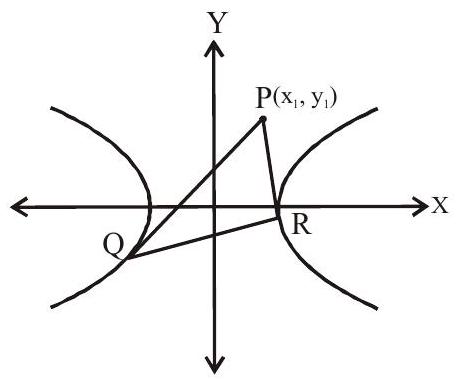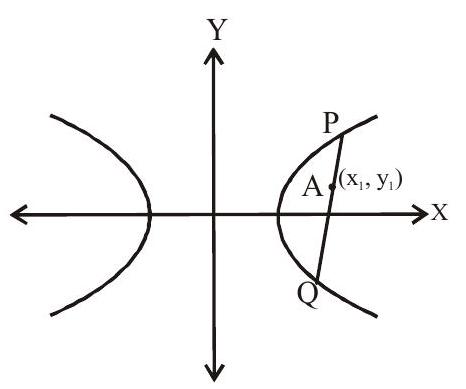HYPERBOLA- 6 (Asymptotes)
Equation of Chord of Contact
Let equation of hyperbola be
Equation of Chord of contact is

Example 1: If tangents of the parabola
(a).
(b).
(c).
(d). none of these
Show Answer
Solution :
Let
Answer: (b)
Equation of the chord of the hyperbola whose mid point is given
ie.

Example 2: The locus of the middle points of the chord of hyperbola
(a).
(b).
(c).
(d). none of these
Show Answer
Solution :
Let mid point of the chord be (
Its slope is
Locus of
Answer: (c)
Asymptotes of Hyperbola
An asymptotes of any hyperbola is a straight line which touches in it two points at infinity. OR If the length of the perpendicular let fall from a point on a hyperbola to a straight line tends to zero as the point on the hyperbola moves to infinity along the hyperbola, then the straight line is called asymptote of the hyperbola.
The equation of two asymptotes of the hyparbola

Pair of asymptotes:
1. If
2. A hyperbola and its conjugate hyperbola have the same asymptotes.
3. The angle between the asymptotes of
4. The asymptotes pass through the centre of the hyperbol(a).
5. The bisectors of the angle between the asymptotes are the coordinate axes.
6. Let
and
be the equation of the hyperbola, asymptotes and the conjugate hyperbola respectively, then clearly
Example 3: The asymptotes of the hyperbola
(a).
(b).
(c).
(d).
Show Answer
Solution :
Since equation of a hyperbola and its asymptotes differ in constant terms only. Pair of asymptotes is given by
It represents a pair of straight line
Asymptotes are
Answer : a, c
Example 4: The equation of the hyperbola which has
(a).
(b).
(c).
(d).
Show Answer
Solution :
Combined equation of the asymptotes is
Since equation of hyperbola and combined equation of its asymptotes differ by a constant, therefore equation of hyperola may be
But it passes through the origin.
Hence equation of hyperbola is
Answer: (b)
Example 5: The product of the lengths of perpendiculars drawn from any point on the hyperbola
(a).
(b).
(c).
(d).
Show Answer
Solution :
Given hyperbola is
Let
Equation of asymptotes is
Product of the lengths of perpendiculars
Answer: (d)
Example: 6 The angle between the asymptotes of the hyperbola
(a).
(b).
(c).
(d).
Show Answer
Solution :
Equations of asymptotes are
slope of first asymptote is
Angle between the asymptotes is
Answer: (b)
Practice questions
1. If angle between asymptotes of hyperbola
(a).
(b).
(c).
(d).
Show Answer
Answer: (d)2. For a hyperbola whose centre is at
(a).
(b).
(c).
(d). none of these
Show Answer
Answer: (b)3. Asymptotes of the hyperbola
(a).
(b).
(c).
(d).
Show Answer
Answer: (d)4. If
(a).
(b).
(c).
(d).
Show Answer
Answer: (a)5. A hyperbola passes through
(a).
(b).
(c).
(d).
Show Answer
Answer: (d)6. The combined equation of the asymptotes of the hyperbola
(a).
(c).
(b).
(d). None of these
Show Answer
Answer: (c)7. The asymptotes of the hyperbola
(a).
(b).
(b).
(c).
Show Answer
Answer: (c)8. If foci of hyperbola lie on
(a).
(b).
(c).
(d). None of these
Show Answer
Answer: (b)Linked comprehension type (for problems 9 - 11)
In hyperbola portion of tangent intercept between asymptotes is bisected at the point of contact. Consider a hyperbola whose centre is at origin. A line
9. Equation of asymptotes are
(a).
(b).
(c).
(d). None of these
Show Answer
Answer: (b)10. Equation of tangent to the hyperbola at
(a).
(b).
(c).
(d). none of these
Show Answer
Answer: (a)11. Angle subtended by
(a).
(b).
(c).
(d). none of these










